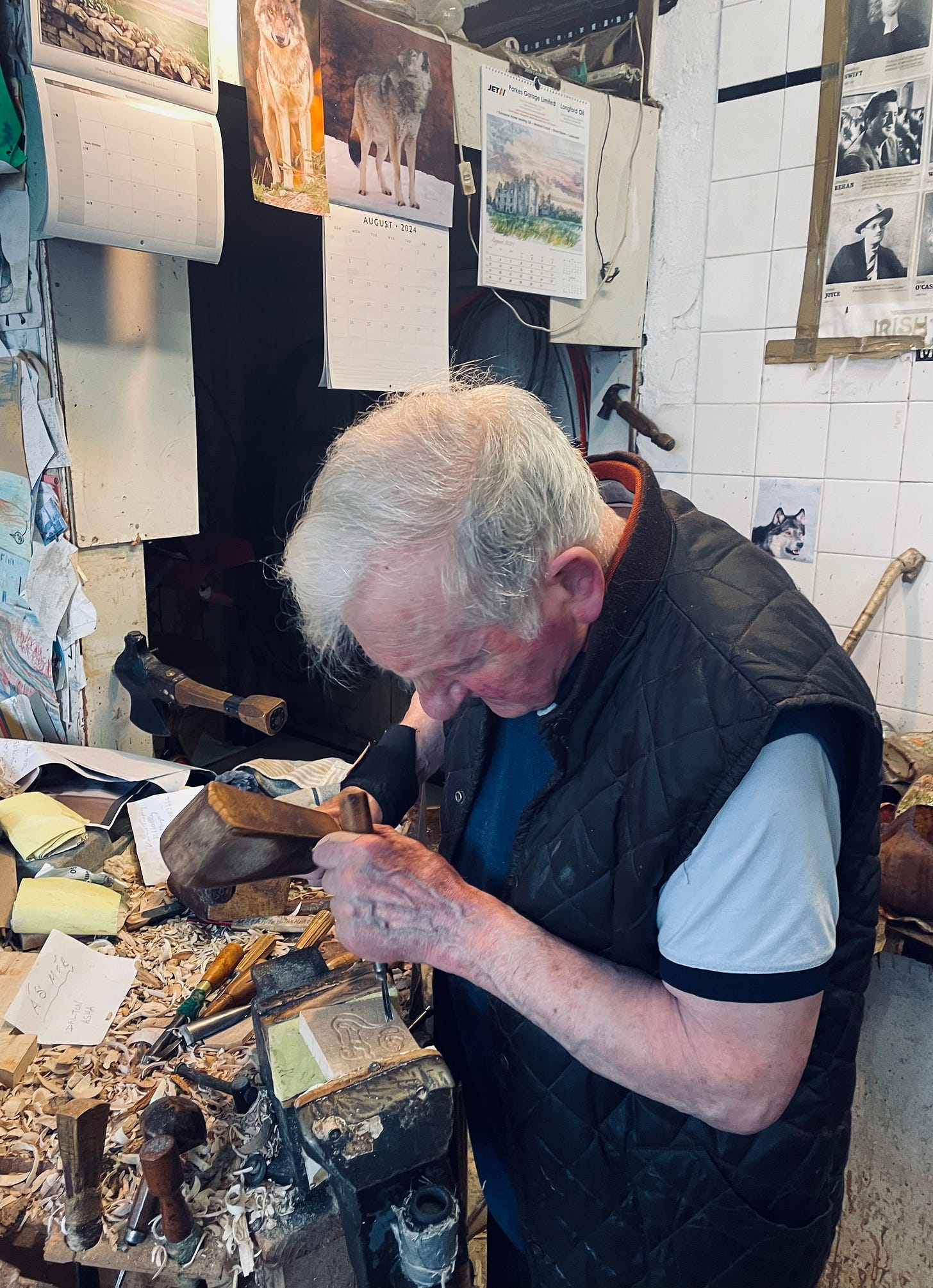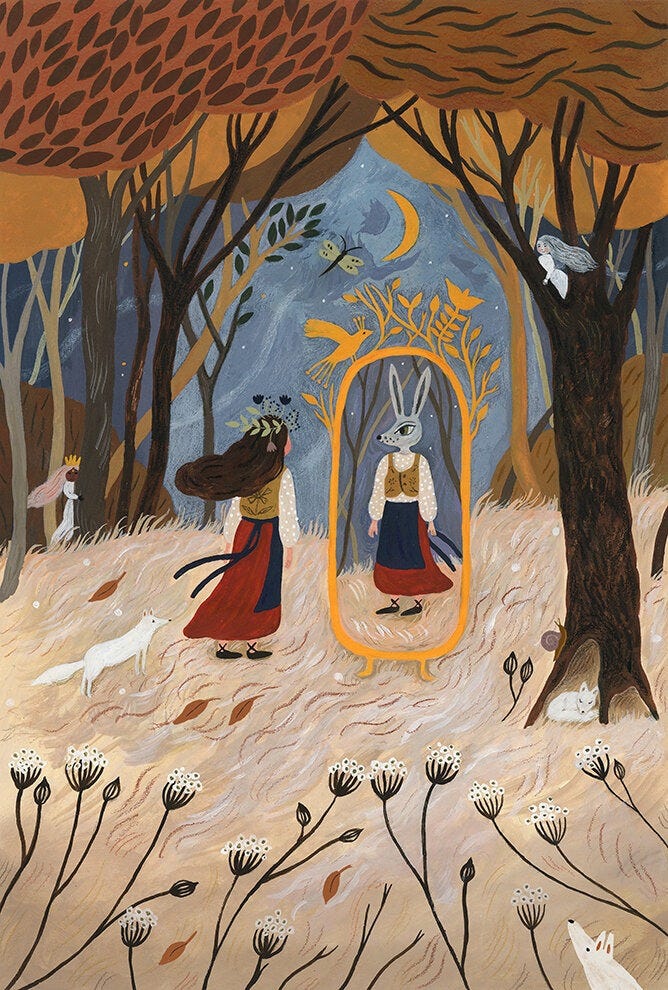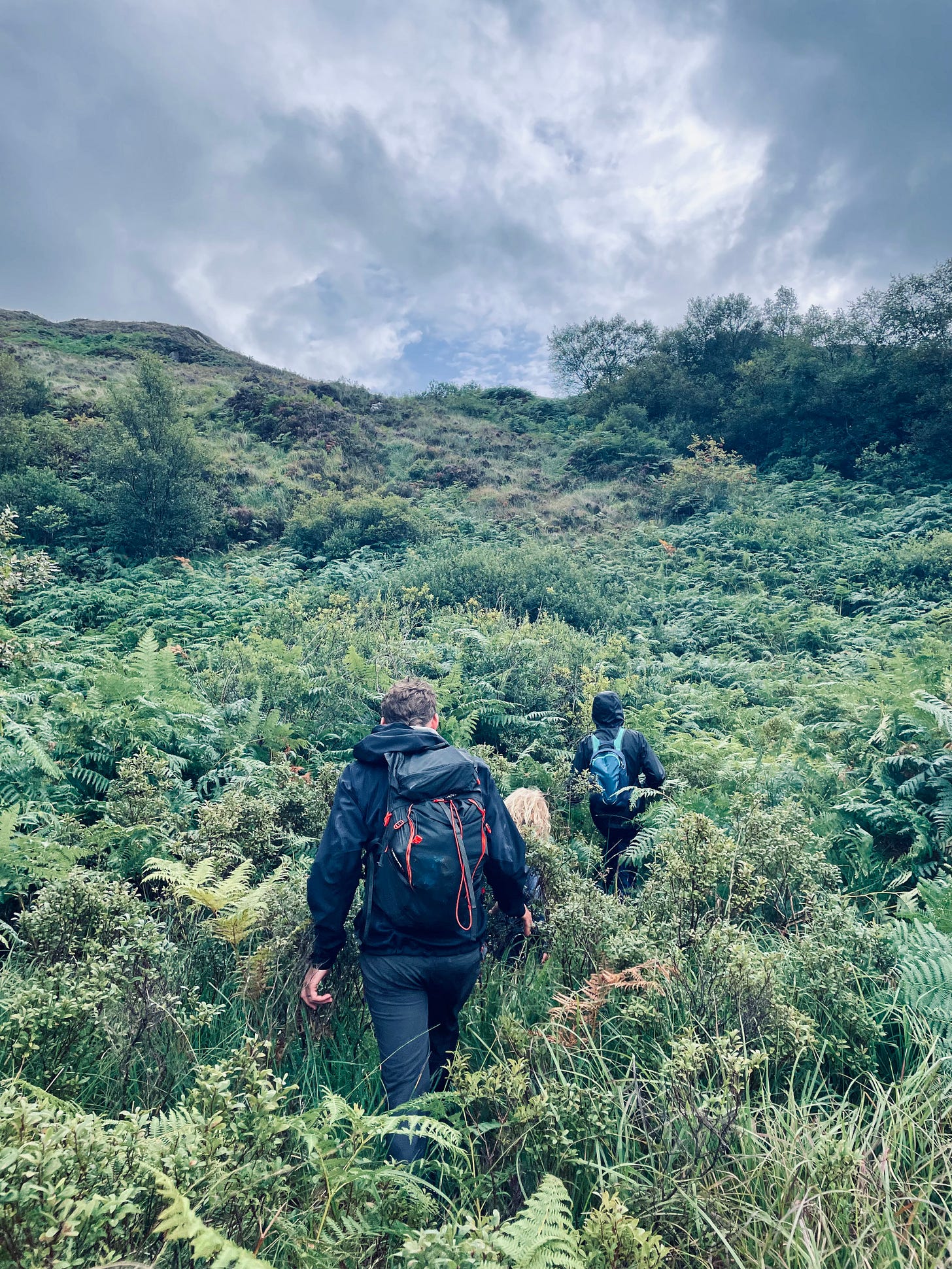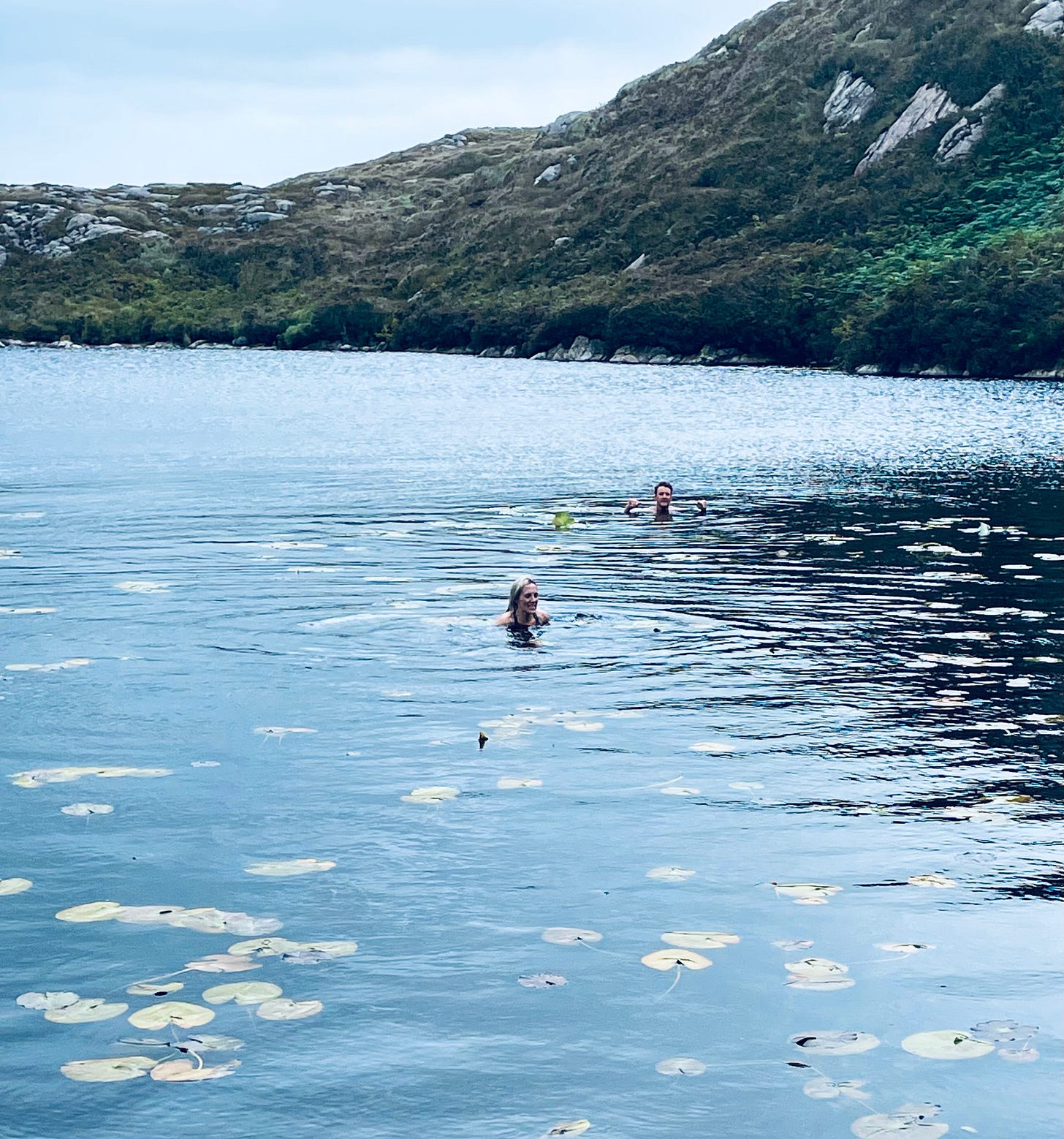
Michael Quirke bent over his notepad and, with oily fingers, gripped the pencil stub and began to draw.
“There’s the river,” he said, tracing its short journey from Lough Gill to the sea.
He sketched a few landmarks: the hospital, the ATU and the bend in the road as it heads out of town.
“There,” he said, marking a cross. “Stand there and look to the hills. You’ll see the breasts of the cailleach1 and her belly between.”
He turned the map over and wrote a word: misneach.
“This is for you. It means courage, but not just courage, it’s spirit and…” he stabbed at his gut, then shook his head. “It doesn’t translate well, you’ll need to take it in the Irish.”
I took his word, and I took his map, and I walked to the place I could see the shapely woman on the horizon. I determined to go there, to the Ballygawley Mountains, where a wise old crone lends her shape to the land.
Lover’s Steps
I recently made a map for my husband. It’s a bit like the flap books I read my children, but with concertinaed pages of instructions, and little doors behind which phrases of our wedding vows are written.
The landmarks relate to ovulation, super moons and treacherous hormonal caverns. There is a lot of blank space because, in my forties, the ground keeps shifting under my feet. Some call it perimenopause, but I prefer a term I read recently: The Quickening.
‘…the use of the word perimenopause is making the vessel of menopause itself leaky, while also ageing us prematurely and possibly contributing to the culture of menopause as a ‘design flaw’. In short, we don’t feel it empowers us.’2
It’s the season of flux in our bodies as we settle into ourselves, shedding those skins that don’t align with our values: people-pleasing, playing small, holding our tongues. But linking it to the menopause lends a waiting room feel to my forties that I don’t like. There’s no winding down yet, if anything, there’s clarity of purpose and a skip in my step.
I find myself listening intently for that which I cannot place. In crowded places, in conversations and when I’m out walking. This receptivity creates a quiet space into which words like misneach drop, or the screech of heron, or my husband’s sleeping breath. It’s the whisper of divinity that connects every living thing and it will not shout to be heard above the opinions and bad advice that abound. I must train my ear to hear.
But there is a lot of inner disruption and I get lost from time to time.
So, I provided some directions. They are circular, not linear, quite vague and with an emphasis on feeling our way when the map falls short. There’s a bit about progesterone and a few lines of Shakespeare on adverse weather:
‘(Love) is an ever-fixed mark
That looks on tempests and is never shaken.’3
It is a wonder I can provide any map at all, I was not given one, and I am not ageing in a culture that honours the wisdom of old women. One of my unteachers, Sharon Blackie, wrote a book about female archetypal elders to whom we can look for inspiration on how to age with fire and fury, wisdom and tenderness.
‘There can be a perverse pleasure, as well as a sense of rightness and beauty, in insisting on flowering just when the world expects you to become quiet and diminish.’4
She also introduced me to the phrase, ‘falling into the land’s dreaming’. It means becoming a student of the land, its geology and mythology, seasons and creatures, as a way of finding our way into the story of what comes next.
This, is how I will find my way.
To Look Laterally
I had trail maps on my phone, a laminated Ordnance Survey Map and GPS satellite images of the Ballygawley Mountains, but I still could not see how one might reach Loch Dá Gé, the Lake of Two Geese.
“There’s magic in the water,” Quirke told me, drawing an arrow on my map.
This small, enchanted lake lies just beneath the summit of Sliabh Dá Eán but there are no trails to follow. The Sligo Way comes close but no-one, it seems, scales the four small peaks of this range.
I became obsessed. These are the mountains I look at from my writing desk, the ones behind which the sun sets in winter. They are both the body of the cailleach and her home; the western-most peak is called the Cailleach’s House and has a chambered cairn on its summit. If I want to re-imagine my second half of life then it is to these mountains I must go.
“You don’t look directly at these stories,” Quirke whispered before I left his shop. “You look laterally.”
So, on my 41st birthday, I declared my intention to swim in the bottomless Loch Dá Gé. My husband raised an eyebrow, then set about packing a picnic.
The mountains are dotted with cairns and passage tombs and are believed to be a marker on a ley line5 crossing the country from Howth through the Hill of Tara, Loughcrew, Sheemor and ending at Knocknarea.
When you look directly at them, they’re just a low lying extension of the Ox Mountains. Maybe that’s all they are. But if you follow the right map, and look askance at the horizon, they’re distinctly feminine and that’s atlas enough for me.
Wait for me
On our wedding day, our best friends sang a Bruce Springsteen song, If I Should Fall Behind. It says:
We swore we’d travel darlin’ side by side
We’d help each other stay in stride
But each lover’s steps fall so differently
But I’ll wait for you
And if I should fall behind
Wait for me.
While we wait, there’s my map. It is full of historical landmarks, helpful travel tips and information on the best time to visit certain territories. For example, there is a time for robust conversation, hospitality and spontaneity. There is also a time for retreat.
This is menstrual cycle awareness, have you heard of it? Possibly not. You’re more likely to have seen advertisements for sanitary wear that enables women to power on through, no matter what is happening in their bodies. As women, this is the most powerful map of all, full of cyclical wisdom and a rhythm by which we can live engaged, creative lives.
It sets the pace in our home. I did not design it this way, I wrote on my map. It’s Her design and She is wise. So we commit every month to respect one another’s different steps, and to wait with great patience and anticipation for the other, if they need a little more time to arrive.
Depth Sounding
We were neck-deep in ferns and had one dry foot between us. On my phone, it looked like the lake was right in front of us, but all the ground we covered brought us no closer to our destination. We left the path an hour ago and we had run out of food.
Our favourite family listening is a real survival stories podcast. The children compared themselves to the stories they’d heard, and were fueled by sheer determination to overcome the odds. I entertained everyone with myths about the bottomless lake.
Once, a farmer was out cutting grass on the mountain. He had a bundle of tools, including his grass hook and sickle. He went missing and it was concluded that he slipped down the steep slope into Loch Dá Gé and drowned. His daughter received the sad news and returned to Ireland by boat. When crossing the Atlantic, she saw her father’s bundle of tools floating in the sea. This is how they know that the lake, in some mysterious way, is connected to the sea.
“Really?” my youngest asked.
“Don’t look at it directly. Give it a sideways glance,” I replied.
He shrugged then pitched himself into a wall of high grass.
I am you

On the front of the map I made for my husband, there is artwork by Tijana Lukovic called I am you. Beneath it, I wrote the title of my creation: Cartography for the Quickening. It is the first of many drafts and for all my work, we could still get hopelessly lost.
On the mountain, with all the resources at our disposal, it took us the guts of two hours to navigate the gullies and exposed gneiss of the mountain before we found the lake. By the end we were following my internal compass and rationing the skittles.
But we made it.
I bent over the surface of the lake. The wind sang in ripples, but I could not discern the words. This is where the cailleach and the mad King Sweeney shape-shifted into geese and competed in a dive to seek the bottom of the enchanted pool. It is a gateway, a portal, a mirror. I tried to get a look at my face. There, reflected in its turf-brown water was my deepest animal self. The one who seeks expression and permission to howl freely. I held her gaze for a moment then, from behind me, my husband yelled, “Last one into the water is a rotten egg”.
I stripped off my hiking layers as fast as a hare.
“Wait for me,” I shouted.
There was no way I could let him get there first.
(And what wisdom did the cailleach impart? I only got the first word, and the story is still being told.)
If, like me, you get lost from time to time, or you know someone who does, here are words for the road:
The Map You Make Yourself by Jan Richardson
You have looked
at so many doors
with longing,
wondering if your life
lay on the other side.
For today,
choose the door
that opens
to the inside.
Travel the most ancient way
of all:
the path that leads you
to the center
of your life.
No map
but the one
you make yourself.
No provision
but what you already carry
and the grace that comes
to those who walk
the pilgrim’s way.
Speak this blessing
as you set out
and watch how
your rhythm slows,
the cadence of the road
drawing you into the pace
that is your own.
Eat when hungry.
Rest when tired.
Listen to your dreaming.
Welcome detours
as doors deeper in.
Pray for protection.
Ask for the guidance you need.
Offer gladness
for the gifts that come
and then
let them go.
Do not expect
to return
by the same road.
Home is always
by another way
and you will know it
not by the light
that waits for you
but by the star
that blazes inside you
telling you
where you are
is holy
and you are welcome
here.
The cailleach is the divine hag of winter from Celtic mythology. She is said to hold sway over the weather and the old stories tell of her creating the mountains by spilling stones from her apron.
Sjanie Hugo Wurlitzer and Alexandra Pope coined this phrase in their book Wise Power.
Sonnet 116: Let me not to the marriage of true minds.
In 1921, Alfred Watkins put forward a proposal that straight lines connect historical landmarks across Britain. Michael Ponder writes about these ley lines in Ireland in his book Pi the Sky. These principles of sacred geometry are hotly contested, but lend a bit of mystery and magic to an everyday hike.









Oh Bethany I loved this! Listening for that voice that won’t shout to be heard ♥️ and Jan Richardson is one of my favourites. I’ve read several books these last few years about the deep mysticism and history of Ireland and your voice is adding to my fascination!
I love the whisper of divinity. Hopkins wrote: ‘The world is charged with the grandeur of God.’ You’re a pioneer, Bethany, leading the way into the old places. Beautiful post. Satisfying swim! 💦